Deacidification of the soil in autumn - affordable and effective ways
 The disturbed acidity of the soil negatively affects the cultivation of garden and vegetable garden plants, impairs the assimilation of applied fertilizers and reduces the yield of crops. Deacidification of the soil in autumn helps to correct the acid-base balance and increase the fertility of vegetables, fruits and berries grown.
The disturbed acidity of the soil negatively affects the cultivation of garden and vegetable garden plants, impairs the assimilation of applied fertilizers and reduces the yield of crops. Deacidification of the soil in autumn helps to correct the acid-base balance and increase the fertility of vegetables, fruits and berries grown.
Determination of soil acidity

For this purpose, you can use several ways:
- Litmus paper - For the test, wrap a few lumps of soil in a thick cloth and place them in several plastic cups. Pour in distilled water and leave for 5 minutes, then dip litmus in each glass for 2 seconds. The red color of litmus indicates an increased acidity level.
- Table vinegar - Place a piece of glass on a dark surface with a lump of soil on top. Pour vinegar on it and evaluate the reaction - hissing indicates high acidity, a small amount of foam indicates neutrality.
- Cherry or currant foliage - pour a glass of water over a few leaves and boil. Dip a lump of earth into this broth. If the liquid darkens, it indicates high acidity. Purple and blue are neutral.
- A pH meter is a device that helps measure the acidity of a soil. At pH values above 5.5, soil deoxidation is required.
- Beets - the acidity level of the soil can be determined by this root crop growing in the garden. The redder and richer the color of the beet tops, the higher the acidity of the soil.

The need for deoxidizing the soil in autumn is indicated by the rapid increase in the number of weeds in the personal plot. Woodlice, plantain, horse sorrel, dandelions and horsetail "prefer" acidified soils.
Deacidification of the soil in autumn - effective ways
 The first thing to do in the fall with acidic soil is to determine by what means the problem of restoring the acid-base level will be solved. Both home remedies and special industrial preparations will help to normalize the acidity of the soil.
The first thing to do in the fall with acidic soil is to determine by what means the problem of restoring the acid-base level will be solved. Both home remedies and special industrial preparations will help to normalize the acidity of the soil.
Soil deoxidation in the fall in the country can be carried out using:
- lime;
- dolomite flour;
- a piece of chalk;
- cement;
- ash;
- gypsum;
- cement;
- soda;
- green manure plants.
The optimal time for these agrotechnical activities is autumn. Before spring comes, the neutralization reaction will end. In case of insufficient decrease in the level of acidity in the spring, you can repeat the procedure, taking into account the rates and timing of the introduction of soil deoxidizers.
Lime deoxidation
 Most often, summer residents and gardeners use lime to deoxidize the soil, since this tool is affordable and highly effective. The only rule is a ban on the use of slaked lime, the rest of the varieties are excellent for normalizing the acid-base balance of the soil.
Most often, summer residents and gardeners use lime to deoxidize the soil, since this tool is affordable and highly effective. The only rule is a ban on the use of slaked lime, the rest of the varieties are excellent for normalizing the acid-base balance of the soil.
The dosage of lime depends on the characteristics of the soil. The higher the acidity level, the more funds are required:
- on average, a dosage of 350-550 g per 1 sq. m;
- for loamy and sandy loam soils, the dosage is reduced to 250-400 g;
- for heavy soil, the amount of lime increases to 400-650 g.
Lime must be scattered on the surface of the soil and sealed in depth to a depth of 12-15 cm using digging.
When liming the soil, it should be borne in mind that limestone can enter into aggressive chemical reactions, destroy plant roots and inhibit the absorption of phosphorus by plants. That is why it is best to apply lime in the fall, immediately after harvesting.
Deacidification with dolomite flour
 Dolomite flour is a product of grinding dolomite mineral containing high concentration of calcium and magnesium. Soil deoxidation with dolomite flour in autumn is one of the most accessible and effective ways to normalize soil acidity. It is not inferior in efficiency to lime and additionally saturates the layers of the treated soil with magnesium, ensuring good plant growth.
Dolomite flour is a product of grinding dolomite mineral containing high concentration of calcium and magnesium. Soil deoxidation with dolomite flour in autumn is one of the most accessible and effective ways to normalize soil acidity. It is not inferior in efficiency to lime and additionally saturates the layers of the treated soil with magnesium, ensuring good plant growth.
 Dolomite flour can be used to deoxidize heavy clay soils. This substance has the ability not only to lower the acidity level, but also to further loosen, soften the structure of the soil and improve its chemical composition. If desired, flour can be used during spring digging, as it does not burn the root system of young plants.
Dolomite flour can be used to deoxidize heavy clay soils. This substance has the ability not only to lower the acidity level, but also to further loosen, soften the structure of the soil and improve its chemical composition. If desired, flour can be used during spring digging, as it does not burn the root system of young plants.
For soil cultivation, it is best to use the finest dolomite flour. The dosage depends on the acidity indicators, on average - 300-500 g per meter of land. The powder must be scattered on the soil surface and dug up to a depth of 15-20 cm.
Ash deoxidation
 Soil deacidification with ash is suitable for soil that requires a slight decrease in acidity. For this purpose, wood, peat ash is used, as well as obtained from burning grass and foliage. All varieties contain a wide range of trace elements - magnesium, potassium, calcium, phosphorus.
Soil deacidification with ash is suitable for soil that requires a slight decrease in acidity. For this purpose, wood, peat ash is used, as well as obtained from burning grass and foliage. All varieties contain a wide range of trace elements - magnesium, potassium, calcium, phosphorus.
The average dosage of ash for autumn deoxidation is 1 kg per 1 sq. m. plot. Ash can be used as a stand-alone deoxidizer or added after lime.
The advantage of this natural remedy is that it can be used throughout the growing season. Improving the quality of the soil with ash can be carried out in various ways - it can be applied simultaneously with digging, or it can be diluted in water and used for irrigation.
Deoxidizing with chalk
 Deacidification of the soil with chalk is carried out after its preliminary grinding. The size of the resulting particles should be no more than 1 mm - large grains dissolve in the soil for several years.
Deacidification of the soil with chalk is carried out after its preliminary grinding. The size of the resulting particles should be no more than 1 mm - large grains dissolve in the soil for several years.
The dosage of chalk for soil deoxidation depends on its characteristics:
- sour - 550-700 g per 1 sq. m;
- medium acid - 350-400 g;
- slightly acidic - 250-350 g.

Chalk can be used both in the fall and in the spring, when digging the soil. The advantage of this method is additional saturation of the soil with calcium and other useful micro- and microelements.
Deoxidation with gypsum and cement
 To reduce the acidity level of the soil, you can use cement powder, which has lost its properties for construction. But this agent must be used in extremely rare cases, since when it is introduced into the soil, it enters into aggressive chemical reactions.
To reduce the acidity level of the soil, you can use cement powder, which has lost its properties for construction. But this agent must be used in extremely rare cases, since when it is introduced into the soil, it enters into aggressive chemical reactions.
A safer and no less effective remedy is gypsum. It is a mineral that contains a high concentration of calcium.
The dosage of gypsum is selected depending on the acidity level of the fertile soil:
- sour - 380-450 g per 1 sq. m;
- medium acid - 280-300 g;
- slightly acidic - 150-280 g.
The main advantage of gypsum is its selective action - this mineral is active only in areas of soil with high acidity. On neutral soil, gypsum does not react and does not affect the physical and chemical characteristics of the soil.
The use of industrial drugs
 To deoxidize the soil, you can use ready-made deoxidizing preparations available in stores for gardeners and gardeners.Industrial products have a complex effect - they not only normalize the acid-base balance of the soil, but also additionally saturate it with valuable nutrients.
To deoxidize the soil, you can use ready-made deoxidizing preparations available in stores for gardeners and gardeners.Industrial products have a complex effect - they not only normalize the acid-base balance of the soil, but also additionally saturate it with valuable nutrients.
Humated soil deoxidizer - a preparation based on humates and calcites. It lowers the acid level and at the same time increases soil fertility. These deoxidizers are available from several manufacturers. The dosage and method of administration of the drug are indicated in the manufacturer's instructions.
 "Lime-Gumi" is a special preparation that is a highly effective deoxidizer and organic-mineral fertilizer. This product contains lime, a significant part of boron, magnesium, nitrogen, phosphorus and potassium, as well as humates. The drug helps to neutralize the reaction of the soil, since a bountiful harvest is possible only on neutral or slightly acidic soil.
"Lime-Gumi" is a special preparation that is a highly effective deoxidizer and organic-mineral fertilizer. This product contains lime, a significant part of boron, magnesium, nitrogen, phosphorus and potassium, as well as humates. The drug helps to neutralize the reaction of the soil, since a bountiful harvest is possible only on neutral or slightly acidic soil.
Soil deoxidation is an effective agrotechnical procedure that is carried out in the fall, after harvest. It helps to normalize the acid-base balance of the soil, to increase its fertility, to ensure the active growth of cultivated plants and the maximum assimilation of the applied fertilizers.